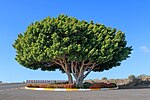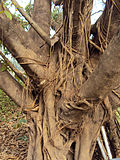lead and cadmium, as well as salt. The symbiotic pollinating fig wasp, Eupristina verticillata, was introduced along with F. microcarpa. Such an introduction...
18 KB (1,846 words) - 18:19, 20 October 2024
1977 Dolichoris Hill, 1967 Elisabethiella Grandi, 1928 Eupristina Saunders, 1882 Eupristina verticillata Waterston, 1921 Nigeriella Wiebes 1974 Paragaon...
11 KB (961 words) - 13:35, 19 July 2024
Blastophaga Blastophaga psenes Courtella Deilagaon Dolichoris Elisabethiella Eupristina Nigeriella Paragaon Pegoscapus Platyscapa Pleistodontes Waterstoniella...
20 KB (1,975 words) - 12:05, 11 November 2024
meters (33–98 ft). Its fruit are eaten by pigeons, and it is pollinated by Eupristina belgaumensis. It occurs in environments ranging from sea-level beachfront...
3 KB (263 words) - 08:53, 3 December 2023
insects available to pollinate the flowers. However, non-native wasps (Eupristina sp.), that have become established in the area, seem capable of pollinating...
7 KB (652 words) - 21:40, 10 April 2024
Australasian realms. They are parasitoids of fig wasps in the Ceratosolen, Eupristina and Kradibia genera. COOK, JAMES M.; BOUTEILLER-REUTER, CAROLINE; HALE...
2 KB (88 words) - 18:43, 6 July 2024
was no suitable pollinator. With the arrival of the non-native wasps (Eupristina sp.), the figs acquired pollinating insects and became invasive. The male...
8 KB (987 words) - 14:10, 24 May 2024
B.B Norden published notes on trap nesting Sri Lankan wasps and bees. Eupristina masoni Karadibia gestroi Platyscapa frontalis Sycoscapter stabilis Watshamiella...
14 KB (1,159 words) - 11:05, 9 April 2024






